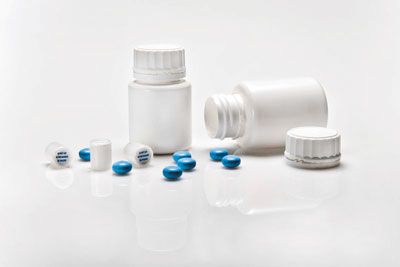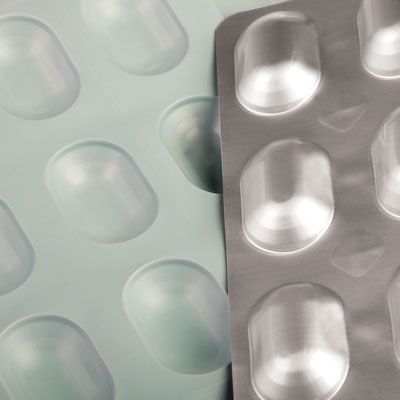Building a Barrier in Solid-Dosage Drug Packaging
New materials and software modeling streamline the blister-package design process.

Protecting the shelf life of drug products can be achieved passively, actively, or as a combination of the two. The geometry of the blister also plays a role. Passive methods rely primarily on building barrier properties into the packaging material using a foil layer, a clear barrier layer, metallization, or a barrier coating. Active methods of shelf-life extension include gas flushing and insertion of a desiccant or oxygen absorber.
Barrier films
A number of barrier materials debuted in 2014, including Flexi FoilFree HB film from Ampac. Laminations that include this ultra-high-barrier film achieve moisture, oxygen, and water-vapor barrier properties similar to aluminum foil laminates. Because of its strong barrier properties, a two- or three-ply Flexi FoilFree HB composite will provide barrier readings equivalent to three- and four-ply foil-based laminates, thereby reducing material costs.
In addition, Flexi FoilFree HB barrier laminates offer better flex-crack and puncture resistance versus foil-based structures and provide easier “tear open” properties. As a result, packaging based on the barrier film tolerates handling better, preventing the shop-worn appearance that can occur with foil-based packaging.
With higher yield and lighter weight, Flexi FoilFree HB barrier laminates generate lower greenhouse gas emissions and require less energy consumption in manufacturing and distribution. “Flexi FoilFree HB-based laminates provide an excellent alternative to more costly aluminum foil composites, with the added benefits of increased puncture and flex crack resistance, as well as improved package appearance and sustainability,” said Dave Bartish, vice-president of Marketing at Ampac, in a statement (1).
Barex alternatives
The October 2014 announcement by Ineos that it is exiting the Barex acrylonitrile-methyl acrylate copolymer business and expects to close the sole plant producing the resin during the first quarter of 2015 has converters and end users scrambling to secure supplies and identify alternatives for barrier films (2). Suppliers offering Barex alternatives include Amcor Flexibles, Bemis, Rollprint Packaging Products, and Tekni-Films, a division of Tekni-Plex. Amcor has secured a three-year supply of Barex resin and has developed an alternative film, which is undergoing trials and is available for sampling (3).
Bemis recommends Barex-based healthcare applications transition into its PerfecPharm P616 or PerfecPharm P619 polyester/foil laminations. In addition to meeting common barrier property requirements for transdermal packaging, these films exhibit low permeation and absorption characteristics. Designed for the healthcare market, the PerfecPharm P616 material features Bemis’s CXB Sealant and exhibits superior seal strength, barrier properties, and inertness. “This new sealant is incorporated into a proprietary laminated structure designed to deliver effective chemical resistance and low absorption rates, exhibiting low reactivity with the medical-grade chemical contents of the package,” explained William E. Jackson, vice-president and chief technology officer at Bemis, in a statement (4).
Clear, high-barrier Exponent 2 film from Rollprint combines its ClearFoil barrier-coated polyester with a coextruded non-crystalline polyester sealant with enhanced sealing properties. “In fact, Exponent 2 offers improved sealing characteristics over Barex due to easier-to-create hermetic seals and improved line speeds,” reported Dwane Hahn, vice-president sales and marketing, Rollprint, in a statement (5).
When compared to traditional, foil-based, high-barrier structures, Exponent 2’s reduced number of layers and gauge offer cost-savings and create an improved environmental profile for lidding, premade or inline pouching, and flow wrap applications. The structure’s clarity and high-barrier properties also make it a lower cost, break-resistant replacement for glass vials. Exponent 2 film has been engineered to provide a chemically neutral, ultra-high oxygen and water vapor barrier with chemical resistance. Maximum barrier properties currently stand at 0.0008 cc/100in2–24 h for oxygen transmission and 0.0008 g/100in2–24 h for water vapor.
Tekni-Films offers stock and custom thermoformable blister/tray film structures as well as heat-sealable pouch/lidding options that reportedly equal or exceed the performance attributes of Barex-based materials. Thermoformable options include polyethylene (PE), polypropylene (PP) and Aclar polychlorotrifluoroethylene inner and outer layers, coupled with barrier layers of ethylene vinyl alcohol (EVOH) and/or cyclic olefin copolymer. Heat-sealable pouch/lidding materials consist of paper/foil/plastic (PE, low-density PE, or polyethylene terephthalate) and EVOH laminations for applications such as transdermal patches and solid- and liquid-dose drug delivery systems (6).
Desiccants and other absorbers
To more actively protect moisture-sensitive products, AdPack desiccant pillow packs and the newer AdCap Desiccant Capsules from Sanner are dispensed into the package prior to sealing. Compatible with standard dispensing equipment, sizes include 1, 2, and 2.5 grams. The desiccant itself consists of silica gel, molecular sieve, or a blend of the two. The capsules adsorb moisture through a cardboard disc on the top as a well as a grid structure on the side, ensuring functionality even if the capsule is lying on the cardboard side. The grid structure also provides a distinctive appearance, minimizing the chance that a patient would confuse it with a capsule or tablet product and accidentally ingest it (see Figure 1). Additionally, good printability enhances the readability of safety instructions (7).

Figure 1: Desiccant capsules adsorb moisture at the top and around the entire side wall (AdCap, Sanner). Figure is courtesy of Sanner.
Mitsubishi Gas Chemical America, the supplier of Ageless oxygen-absorbing sachets and PharmaKeep oxygen-absorbing desiccants, also supplies oxygen-absorbing Ageless OMAC barrier film and pouches and builds oxygen-absorbing qualities into the container itself by coextruding a multilayer barrier structure. The OxyVanish bottle consists of six layers: high-density PE/adhesive/EVOH/adhesive/oxygen absorber/linear-low-density PE. Five container sizes are available: 30, 35, 40, 60, and 100 mL. For moisture-sensitive applications, Mitsubishi offers MoistVanish containers with a built-in desiccant (8).
An active packaging option of a blister packaging standard, cold-form foil, maximizes moisture protection by replacing the traditional polyvinyl chloride layer with a PE/desiccant blend (see Figure 2). Constantia DryFoil rollstock from Constantia Flexibles seals to a broad range of PE-based lidding materials that run on standard cold-form blister lines (9).

Figure 2: A desiccant-equipped layer maximizes moisture protection (Constantia DryFoil, Constantia Flexibles). Figure is courtesy of Constantia Flexibles.
Optimizing blister structures
Selecting a barrier material and structure to meet shelf-life requirements generally requires lengthy trial-and-error testing. A marketing alliance recently established between Klöckner Pentaplast and FreeThink Technologies can shrink that time frame to as little as three weeks and eliminate the cost of line trials to forecast barrier needs for pharmaceutical products. At press time, three projects were already underway.
The alliance optimizes both blister geometry and materials structure by creating predictive models using Klöckner Pentaplast’s Pentapharm BlisterPro blister geometry optimization technology and FreeThink’s ASAPprime accelerated stability assessment software and laboratory services. The combination of product stability and blister package models “allows drug manufacturers to narrow material choices early,” explained Michael Rashed, senior manager, Global Marketing, Pharmaceutical Films Division, Klöckner Pentaplast, in an interview with Pharmaceutical Technology at PACK EXPO International (Nov. 2–5, 2014, Chicago). Optimizing for multiple climate zones also “increases speed to market, minimizes packaging, and offers the potential for eliminating overpouches and desiccants,” he added.
“Our accelerated stability science has allowed us to provide drug and consumer product customers a fast and accurate way to determine … product shelf-life,” said Dr. Kenneth Waterman, CEO, FreeThink Technologies, in a statement. “With Klöckner Pentaplast’s expertise and wide range of films available, we can now also provide customers with the right blister materials for stability and determine the specific blister structure and tooling design needed to optimize performance and cost. In addition, Klöckner Pentaplast has the ability to prototype and produce appropriate blister packaging for the customers to help get products to market quickly” (10).
Although targeted primarily to pharmaceutical blister packaging, the optimization technology can be used for other packaging formats and product types. The optimization process consists of five steps:
The ASAPprime software and laboratory services build a scientific and statistical model of a drug product’s stability and determine the barrier properties needed to achieve the desired shelf life.
Pentapharm BlisterPro software computationally models the appropriate blister geometry for the product based on specifications and mechanical functionality.
Combining the FreeThink ASAPprime barrier requirements for adequate product stability with BlisterPro Finite Element Analysis software allows Klöckner Pentaplast to accurately determine the appropriate barrier materials needed to balance stability needs with cost effectiveness.
With blister geometry and barrier material optimized for the product, an electronic template is generated so prototypes can be produced on a blister machine at Klöckner Pentaplast. Resulting samples undergo performance and stability testing.
The modeling “increases the probability of passing stability,” noted Daniel Stagnaro, director Pharmaceutical Films, Americas, Klöckner Pentaplast, during an interview at PACK EXPO. “As a result, structures don’t need to be over-engineered for launch,” he concluded.
References
1. Ampac, “Ampac Introduces Flexi FoilFree HB Ultra High Barrier Film,” Press Release, Oct. 22, 2014.
2. Ineos, “Ineos Announces Planned Closure of Barex Plant,” Press Release, Oct. 29, 2014.
3. Amcor Flexibles, “Amcor Flexibles Secures Three Years Supply of Barex Resins and Launches Alternative High-Performance Film,” Press Release, Nov. 4, 2014.
4. Bemis, “Bemis Proprietary Films Provide Commercial Alternatives to Barex Resin-Based Packaging Solutions,” Press Release, Nov. 19, 2014.
5. Rollprint Packaging Products, “Rollprint Introduces Exponent 2 Chemically Resistant, Clear Flexible Film for High-Barrier Pharmaceutical Applications,” Press Release, Oct. 31, 2014.
6. Tekni-Films, division of Tekni-Plex, “Tekni-Films Announces Extensive Line of High-Barrier, Barex-Alternative Specialty Films for Thermoformable, Heat-Sealable Packaging Applications,” Press Release, Nov. 19, 2014.
7. Sanner, “New AdCap® Desiccant Capsules from Sanner,” Press Release, Nov. 10, 2014.
8. Mitsubishi Gas Chemical America, “OxyVanish (Oxygen Absorbing Bottle),” Technical Data Sheet, http://ageless.mgc-a.com/OxyVanish%20technical%20data.pdf, accessed Dec. 1, 2014.
9. Constantia Flexibles, “Constantia Flexibles Introduces Coldform Foil Solution Offering Maximum Moisture Protection,” Press Release, Sep. 23, 2014.
10. Klöckner Pentaplast, “Klöckner Pentaplast and FreeThink Technologies Announce Innovative Marketing Alliance,” Press Release, Nov. 2, 2014.
About the author
Hallie Forcinio is Pharmaceutical Technology's Packaging Forum editor, 4708 Morningside Drive, Cleveland, OH 44109, tel. 216-351-5824, editorhal@cs.com.
Article Details Pharmaceutical Technology
Vol. 39, Issue 1
Pages: 54-56
Citation: When referring to this article, please cite it as H. Forcinio, "Building a Barrier in Solid-Dosage Drug Packaging," Pharmaceutical Technology 39 (12) 2014.

Pharmaceutical Tariffs Are Imminent: How Industry is Bracing for Impact
April 16th 2025On April 14, 2025, the Trump Administration launched a national security-driven investigation into pharmaceuticals, a move that will likely result in tariffs being placed on pharmaceutical drugs, ingredients, and other components that are imported from outside of the United States.
Drug Solutions Podcast: A Closer Look at mRNA in Oncology and Vaccines
April 30th 2024In this episode fo the Drug Solutions Podcast, etherna’s vice-president of Technology and Innovation, Stefaan De Koker, discusses the merits and challenges of using mRNA as the foundation for therapeutics in oncology as well as for vaccines.